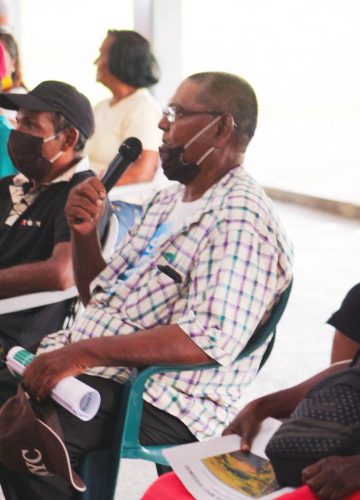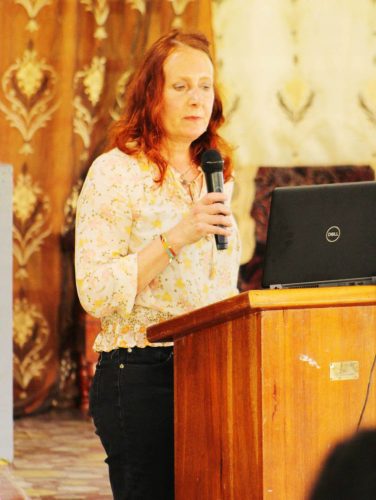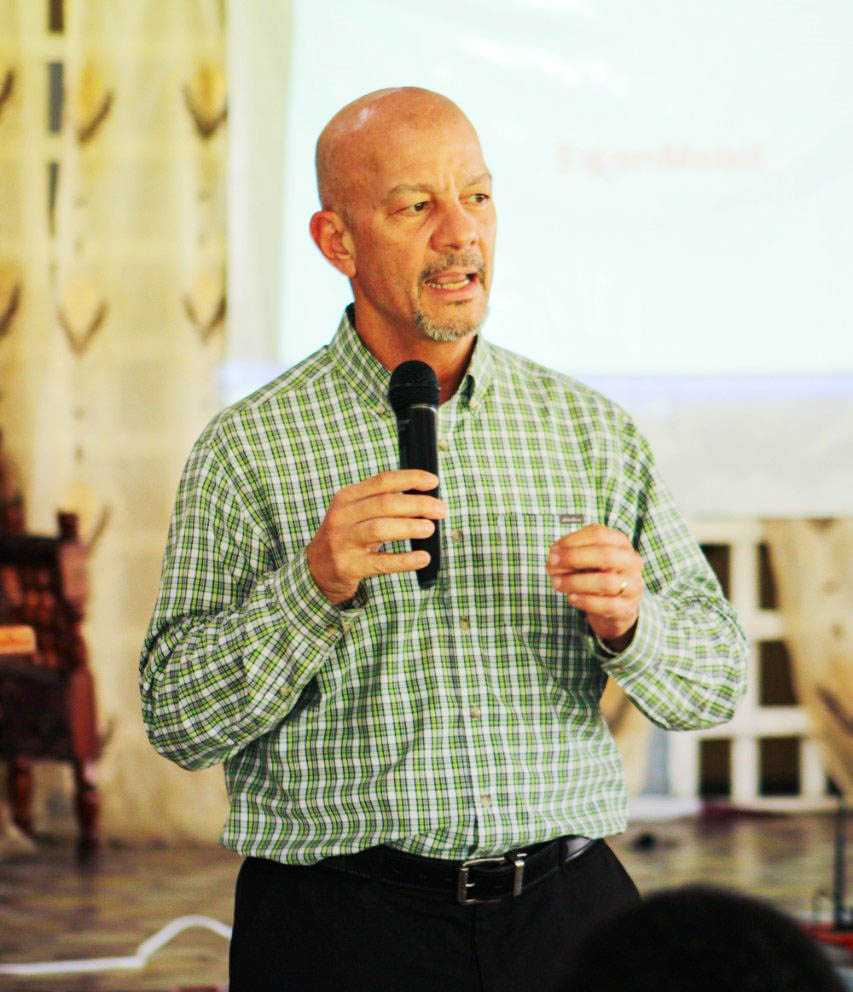Amid controversy over the use of one consultant for all of its environmental impact studies, ExxonMobil’s subsidiary, Esso Exploration and Production Guyana Limited (EEPGL) has revealed that the next study will not be executed by ERM.
This was revealed by the Manager for the Gas to Shore Project, Friedrich Krispin during a public discussion at the West Demerara Secondary School, Pouderoyen, West Bank Demerara (WBD) yesterday. The sessions are being held by Environmental Resources Management (ERM) to discuss the findings of its Environmental Impact Assessment (EIA) for the gas to shore project which is expected to run from the Stabroek Block offshore Guyana and land at Wales, WBD.

ERM has conducted the environmental studies for Exxon’s Liza 1, Liza 2, Payara and Yellowtail developments offshore Guyana. It is now conducting the fifth EIA for the gas to shore project and observers have been consistently raising concerns as to the independence of both ERM and the studies. Both ERM and EEPGL have remained quiet when asked about the relationship.
At yesterday’s public discussion meeting, Stabroek News asked both entities to address their relationship as well as ERM’s independence.
Krispin said that while he cannot account for the previous times that ERM has been chosen, he can assure that their work is of a high standard.
“Even though I have been doing this (gas to shore project), I do not know how many they have been involved in and

whether they have done a good job, I suppose they have. Normally, what we do is we bid on these jobs and sometimes you find a contractor that does a very good job and you continue working with them because they understand Guyana. They understand local requirements and there is no learning curve for a contractor like that to come up to speed on a new project,” Krispin related.
He added, “…interestingly the next project is not going to be done by ERM.”
EEPGL’s next development is the Uaru+ project. The company has already approached the Environmental Protection Agency (EPA) seeking an environmental permit. The EPA has decided that an impact study would be required and scoping consultations will commence on May 16.
It is unclear if it is this project Krispin referred to when he said that ERM would not be involved in the impact assessment and efforts to follow up were unsuccessful. However, it does now raise questions as to what led Exxon to choose another consultant and whether ERM on its own has decided not to bid for the project.
Meanwhile, ERM’s Technical Director Julia Tims defended their relationship with Exxon by saying that the work speaks for itself.
“ERM is an international consultancy. We specialize in sustainability and impact assessment. We do impact assessments all over the world for many, many different types of clients, different industries [and we have] worked with Exxon for a long time, but that in no way affects our objectivity when we’re conducting assessments.
“Our value to a company like Exxon or any other company that we work for is our independence. Our reputation is built on independence and our absolute integrity in everything that we do,” she said.
Tims said that they have partnered with a number of Guyanese consultants and specialists to conduct the gas to shore EIA. She added that the local specialists were allowed to take the lead on the various studies since they are far more aware of the landscape.
“…they will attest to the fact that we hired them because of their technical expertise. They know Guyana, they know these resources and they led all the studies that went into the impact assessment process. Where ERM really comes in is through the impact assessments side where we have a specialty in the standardized process, the methodology, internationally accepted practices for impact assessments, how it is conducted, and developing a standardized method for impacts in identifying management numbers, things like that.
“We have a global team that has worked on this project, encompassing over 100 persons, one hundred specialists and all of the persons came on the project, evaluating [the] project on its merits and nothing to do with our relationship with Exxon or anything else. That’s where independence comes and our integrity so we stand behind the work that we have done,” she asserted.
Consultations
Yesterday’s session was the ninth of 11 public-disclosure meetings ERM has planned as part of the public comment period on the EIA. However, one that has been consistently raised is the lack of consultations with the residents in the path of the pipeline during the preparation of the EIA.
The pipeline is expected to land at Crane/Nouvelle Flanders, West Coast Demerara and make its way to Wales on the West Bank of the Demerara. The project will involve capturing associated gas produced from crude oil production operations on the Liza Phase 1 (Destiny) and Liza Phase 2 (Unity) Floating, Production, Storage, and Offloading (FPSO) vessels, transporting approximately 50 million standard cubic feet per day (MMscfd; 1.4 million standard cubic meters per day [MMsm3/d]) of gas via a subsea pipeline and then an onshore pipeline to a natural gas liquids (NGL) processing plant (NGL Plant), treating the gas to remove NGLs for sale to third parties, and ultimately delivering dry gas for use at the Power Plant.
The project includes the construction and operation of a natural gas pipeline from the Liza Phase 1 (Destiny) and Liza Phase 2 (Unity) FPSO vessels via a subsea line and then an onshore natural gas pipeline to an onshore NGL Plant. The pipeline will transport up to approximately 50 MMscfd of dry gas to the NGL Plant. The NGL Plant will drop the pressure of the gas; dehydrate the gas; separate out the NGLs (i.e., propane, butane, and pentanes+) for sale to third parties; and treat the remaining “dry” gas to the specifications appropriate for use as fuel or raw materials by third parties.
The EIA was done to account for the impact of both the NGL plant and the pipeline. The general conclusions of the study indicate that the effects on the environment are mostly negligible.
The project is pegged at US$1.3 billion and the government hopes it will lead to vastly lower energy costs that would enable a spurt in manufacturing. However, there have been doubts over the country’s execution capacity and whether a feasibility study has been done for this massive project which would be the biggest in the country’s history.
At yesterday’s consultation, Canal Number One, WBD resident Mohabir Persaud said that he farms over 100 acres of rice and pineapples in an area called Java at Canals Polder. The man told Exxon and ERM officials that he has not been consulted in a meaningful way on how he would be made to adapt after the pipeline is laid. He informed them that he has been told that the pipeline would be landing in the area where he farms and lives and that he is on its direct path.
As part of the protection mechanism for the onshore pipeline, EEPGL will create a designated right of way for the line. According to Persaud, the right of way is expected to cut off his access to farmlands and the elderly man is concerned about the compensatory scheme as well as the lack of information from the consultants and the government.
In response to his concerns, Krispin said that EEPGL is working with the government to come up with a livelihood and resettlement scheme that reflects international standards. Additionally, he told Persaud that the government is responsible for the path which the pipeline takes as well as the relocation and acquisition of any property on the right of way.
Persaud also questioned whether the right of way (RoW) would prevent him from accessing his farmlands to which Krispin explained that while there will be restrictions on what can be done in the vicinity of an RoW, Persaud can use it to access his farmlands.
The farmer also called for more consultations particularly with the residents of the Canals Polder area since they are in the direct path of the pipeline and stand to be affected greatly. There was also a collective call for more education on the project.
“We nah have nothing against the pipeline but them got to give we more information on this thing. Nobody nah tell we nothing about it and only one time some people come and tell me the pipeline go land where me a plant and that was it. This (consultation) is good but … come in the area where we live and get a vision of how the pipeline go land and then tell people what y’all go do,” Persaud said.
Tims admitted that ERM is aware of the area of which Persaud speaks and reiterated what is stated in the EIA about a resettlement plan.
“So as part of the recommendations made in the EIA, there is the recommendation for the establishment of resettlement and Economic Cooperation Framework and that will be drafted in accordance with national standards of best practice. EEPGL has committed to developing the strategy and supporting the government in its implementation.
“The government per the laws of Guyana will be the responsible party for establishing the compensation agreements …EEPGL has agreed to develop strategies to support the government ensuring that it’s done in the most equitable way possible,” Tims informed.
The government has been largely silent on the impact of its part of the project since it will be responsible for the construction of the power plant. However, at an earlier consultation, Krispin did say that the government may also be responsible for the NGL plan.
The EIA was done to account for the impact of both the NGL plant and the pipeline. The general conclusions of the study indicate that the effects on the environment are mostly negligible.
The final public disclosure meeting is slated for the Patentia Primary School at 3 pm tomorrow.






